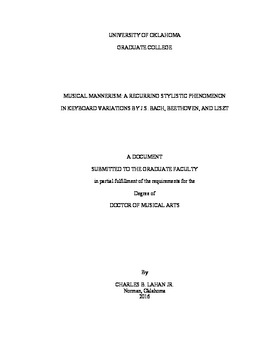| dc.description.abstract | ABSTRACT
Mannerism was an artistic style that flourished in the sixteenth century between the High Renaissance and the emergence of the Baroque era. Originating in Rome and Florence in the 1520s, Mannerism eventually spread throughout Europe. Important Mannerist painters include Michelangelo, Pontormo, Parmigianino, Rosso, Bronzino, and El Greco.
Mannerism as an artistic style was not limited to painting and the visual arts. Mannerism thrived throughout the sister arts as well. Notable examples of Mannerism can be found in architecture, literature, and music. In music, the Italian madrigal is the purest expression of the Mannerist style.
From roughly 1600 until 1900, the dominant critical view of Mannerism was negative. Mannerism was viewed as a degradation of the virtuous style of the Renaissance. As a result, Mannerism was largely ignored by critics and scholars. However, in the early twentieth century, this view began to change as scholars from across the artistic disciplines began studying Mannerism with renewed interest. A common goal amongst many of these scholars was to imbue Mannerism with positive qualities.
As scholars began to focus on this neglected style, ideas about Mannerism proliferated. One such idea that has gained traction across disciplines is that Mannerism is a recurring stylistic phenomenon not necessarily isolated to the sixteenth century. A proponent of this idea in the field of music was Canadian musicologist Maria Rika Maniates.
This document seeks to expand on Maniates’ arguments concerning recurring Mannerism. Specifically, this document will provide an overview of the history of Mannerism and analysis of keyboard works using Maniates’ criteria for recurring Mannerism. The keyboard works are J.S. Bach’s Goldberg Variations, Ludwig van Beethoven’s Diabelli Variations, and Franz Liszt’s Variations on a Theme of Bach, Weinen, Klagen, Sorgen, Zagen. | en_US |
